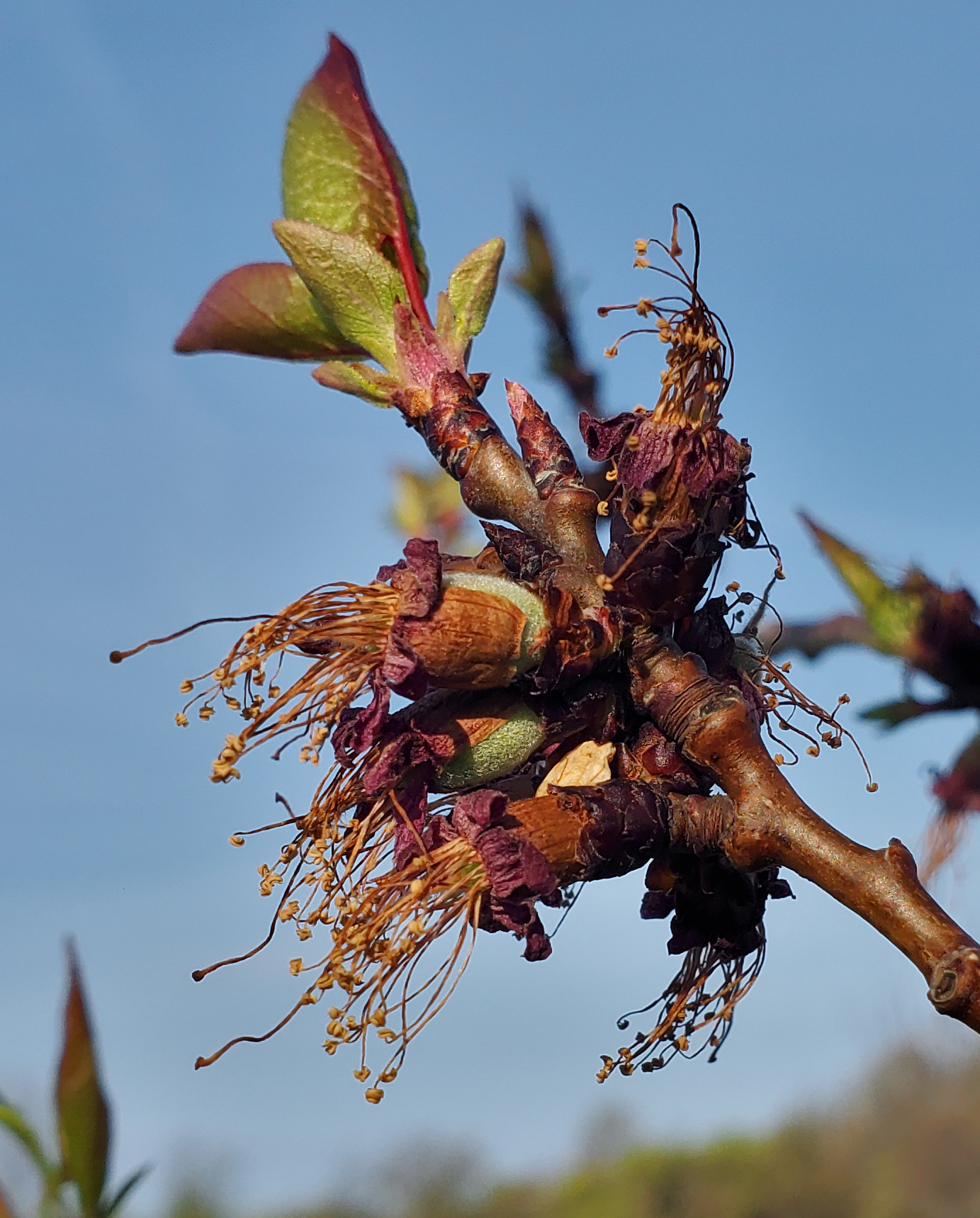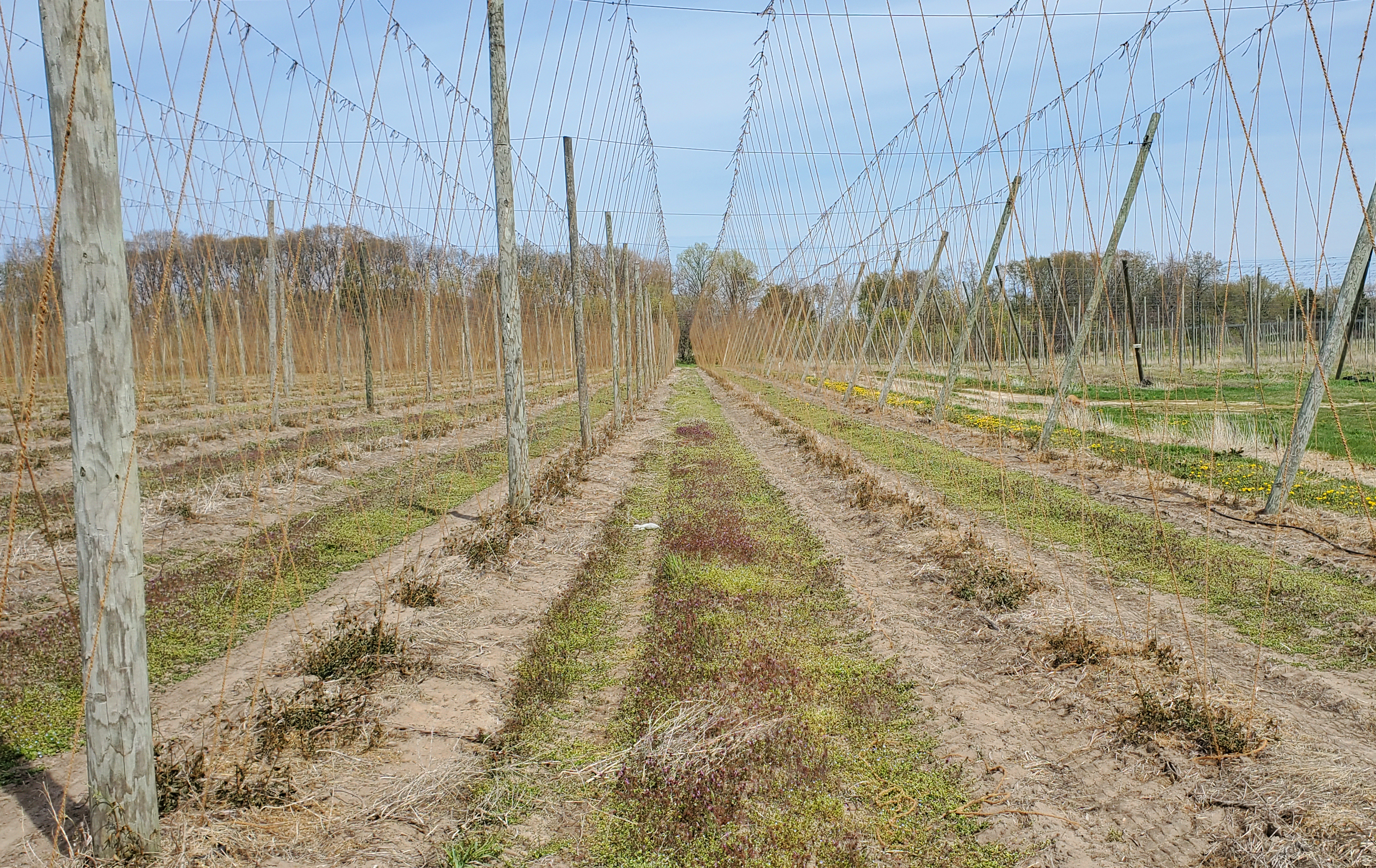Southwest Michigan fruit update – April 27, 2021
The freezes on Wednesday and Thursday mornings damaged most fruit crops. Few areas saw serious damage.

Weather
Last week was cold. A storm system on Monday afternoon, April 19, brought a quarter inch of rainfall. High temperatures were in the 40s for the first part of the week, climbing to the 50s by the weekend. Lows began in the 30s. Wednesday and Thursday saw the coldest mornings of the week. Low temperatures in the 20s were reported in all areas of southwest Michigan.
This week is expected to be much warmer. Tuesday should see close to 80 degrees Fahrenheit. The rest of the week should see highs in the 50s and 60s with lows well above freezing. The best chances of rain are on Wednesday and Thursday.
Soil temperatures have fallen into the mid-40s in many areas. With the cold week, we picked up very few growing degree days (GDD) last week: 20 GDD base 42 and 5 GDD base 50.
|
Southwest Michigan GDD summary from March 1 - April 25, 2021 | |||
|---|---|---|---|
|
Station |
GDD 42 F |
GDD 45 F |
GDD 50 F |
|
Benton Harbor (SWMREC) |
349 |
268 |
161 |
|
Lawton (Lawton) |
354 |
272 |
163 |
|
Fennville (TNRC) |
292 |
220 |
128 |
|
Average for the SW region |
344 |
264 |
160 |
|
Average last week |
324 |
252 |
155 |
Frost/freeze information
April began with a classic radiation freeze on Friday, April 2, 2021 with low temperatures dropping into the mid- and upper teens. The coldest temperatures were along the I-94 corridor (12-15 F). There were warmer temperatures to the south. Damage has been observed in various tree fruit including apricots, peaches and apples with cherries the most impacted.
Last week saw more freeze events with two very cold nights. Wednesday’s freeze, on April 21, saw the coldest temperatures. Some areas recorded 21-24 F. The coldest areas on Wednesday were away from the lake. The freeze was more widespread on Thursday morning with all parts of southwest Michigan seeing lows in the mid- to upper 20s. Most tree fruit are at or near bloom. They can be damaged by temperatures in the upper 20s. Many small fruits can be damaged by temperatures in the low to mid-20s.
Damage from last week’s freezes is being seen in most crops. With the warm weather predicted this week, damage will be more noticeable soon. We should be able to predict the fruit crops better after bloom when the results of these freezes and the success of pollination are more apparent.
Tree fruit
With the warmer weather we are seeing renewed fruit tree development. Damage from the April 2 freeze is obvious in cherries as tiny, blackened pistils. The damage from the April 21 and 22 freezes appears as discolored, nearly or full size pistils, and in some cases pistils with dark cores. Some pistils look weak and somewhat watery. Here is a link to tree fruit bud critical temperatures and another with pictures.
Oriental fruit moth biofix occurred approximately two weeks ago, but little significant moth flight has occurred since. Oriental fruit moth activity should increase significantly this week. Mating disruption for moth species, especially for oriental fruit moth and codling moth should go out soon in order to be in time for the first generation. According to the model on Enviroweather, codling moth biofix should occur in the warmer areas this week. There are a few weeks before obliquebanded leafroller biofix.
Apricots are beginning shuck split. The crop looks to be quite variable from site to site. Plum curculio will become a concern once we start seeing warm evenings. Brown rot will be an issue with warmer weather.

Peach and nectarine are in an extended bloom period, ranging from 50% to early petal fall. Freeze damage in peaches is becoming easier to see, but crop prospects are still decent in many sites. Oriental fruit moth biofix was predicted on April 6-8 depending on site, but trap catches are generally very low. Catches should increase this week, indicating mating.
In cherries, tarts are at full bloom to early petal fall and sweets are generally at petal fall and in the shuck. The freezes on April 2, 21 and 22 hurt both tart and sweet cherries, but tarts have the best prospects for decent to good crops, depending on the site. Cherry leaf spot infections have been slowed by cool weather but will become a bigger concern when temperatures are consistently above mid-50s.

In plums, Japanese plum buds are at petal fall to in the shuck. European plums are at early petal fall. Crop prospects still look decent, but it remains to be seen how many fruit will stick on the tree. Poor pollination and frost damage can increase split pit problems at harvest. Black rot control is still ongoing, and brown rot management will be important as temperatures rise.
Apple buds are generally at full pink or first bloom, depending on the variety. Many of the most advanced blooms were damaged by last week’s freezes. Local monitoring sites showed increased apple scab ascospore catches over the past 10 days. Although there have been frequent rains in April, few of them have been long enough for scab infections. Warmer temperatures and bloom this week raises concerns about fire blight.
Notching and plant growth regulator treatment of young trees can help induce lateral bud development. Promalin treatments for fruit elongation (Gala and Red Delicious) are going on now. The blossom thinning window for lime sulfur/oil and ammonium thiosulfate treatment is beginning soon. Assessment of crop damage by frost is important before commencing thinning sprays.
Pears are at full bloom.
Small fruit
Grape buds are swollen. Concord and other earlier hybrid varieties are at late bud swell and should burst and throw out leaves soon. Most vinifera are still at early bud swell. As buds open, climbing cutworms and flea beetles are less of a problem. It does not appear there was significant damage from freezes last week, but some primaries were killed in advanced or colder sites.
Blueberry flower buds have burst. Early varieties are at early pink bud. There was freeze damage in some sites, but it is not widespread or severe. The leaves of vegetative buds are unfolding. See Blueberry Growth Stages for descriptions and estimates of the critical temperatures for each bud stage.
With the rain forecast for this week, protect against mummy berry. Green tissue and mummy berry mushrooms (apothecia) are out. Freeze damaged leaves are more susceptible to infection and rainy conditions later this week could be mummy berry shoot strike infections. Apply fungicides to protect the green shoots.
In strawberries, most new leaves have emerged from the crown and flower trusses are emerging from the crown. Growers report some damage to the flowers from last week’s freeze. Overwintering mulches should be removed and raked between the rows after this week’s freezes. As flower buds emerge growers should consider sprays to protect against strawberry clipper.
Bramble leaves are opening up. In summer bearing raspberries, last year’s primocanes should be headed (cut back) to the desired height and any remaining floricanes from last year should be removed. Fall bearing raspberry primocanes are emerging from the ground.
Miscellaneous crops
Hops were damaged by last week’s freeze but many sites will still need pruning. Some sites have begun stringing. Downy mildew spikes have been reported. With the warmer weather forecast this next week, fungicide applications for downy mildew control may be warranted.

Chestnut buds are swollen.
Hazelnut leaves are out. Some damage to leaves and developing buds has been seen.
Paw Paw buds are swollen.
Upcoming meetings
Our regular Southwest Michigan Monday Fruit IPM Updates are available online. You need to register to receive the Zoom link and password for these meetings. The webinars are free and one pesticide applicator credit is available for each meeting. We had over 70 growers attending our Monday meetings last year.
Related articles
- Freeze damage depends on tree fruit stage of development
- Using Enviro-weather’s regional overnight temperature report during cold events
- Treat peach leaf curl now
- Managing bacterial canker in sweet cherries: What are the options?
- Early insect control with horticultural oils
- Dormant oil for tree fruit pest management in 2015
- Scouting and management of mummy berry in blueberries
- Mummy berry has returned, and new products are available for control
- Monitor grape buds for climbing cutworm and flea beetles
- Frost, Critical Temperatures, and Frost Protection
- What can fruit growers do if a freeze is coming?



 Print
Print Email
Email




